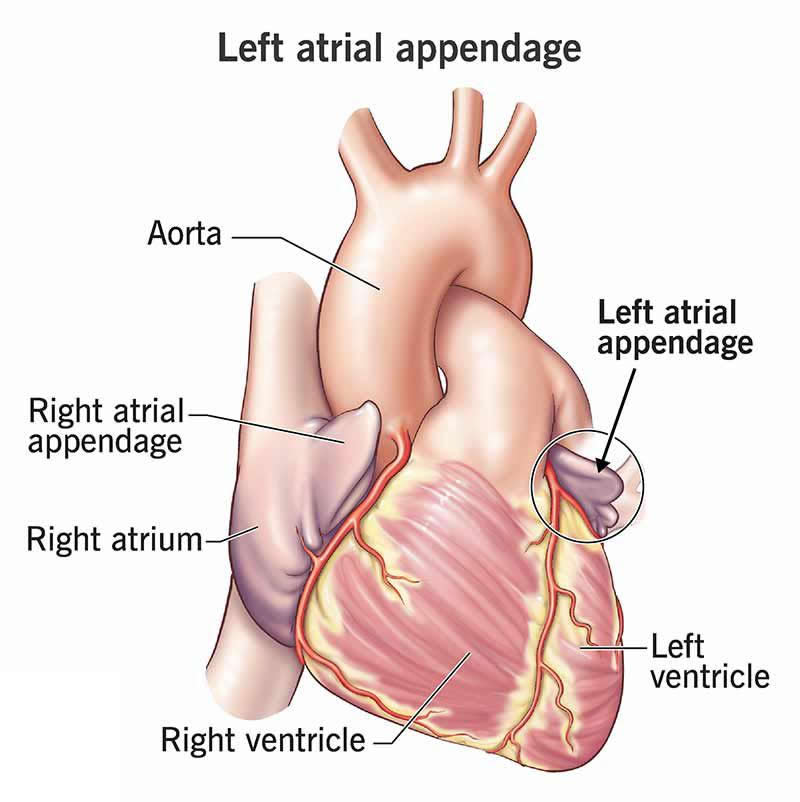Left Atrial Appendage
Your left atrial appendage (LAA) is a small pouch of tissue that extends out from your left atrium (upper heart chamber). It’s in a groove between that chamber and the one below it. The number of lobes in your LAA varies from person to person, and so does the shape. The most common shape looks like a chicken wing.
Overview

What is a left atrial appendage?
A left atrial appendage (LAA) is a pouch of muscular tissue that sticks out of your heart. It connects to the wall of your left atrium (upper heart chamber).
You may only hear about your left atrial appendage if your healthcare provider wants to close it off. Closing, removing or blocking it can reduce stroke risk for people with atrial fibrillation (Afib). This is because most blood clots form in the LAA in people with Afib. But don’t worry; your heart doesn’t need your LAA to do its job.
Function
What does your left atrial appendage do?
The function of your left atrial appendage is to manage the amount of blood in your heart. It does this by releasing natriuretic peptides (proteins) when blood volume is high enough to make your LAA walls stretch too much. These peptides go into your bloodstream and encourage your kidneys to get rid of more salt and water (in pee). The peptides also loosen your blood vessels. These actions can lower your blood pressure.
You may wonder what happens to your peptide levels if you have a procedure to remove or block your left atrial appendage. After three months of abnormal levels, peptide amounts tend to go back to normal.
Typically, high levels of these peptides may mean you have heart failure. With this condition, your body is trying to get rid of extra fluid because your heart can’t handle a large volume of blood.
Anatomy
Where is it located?
Your left atrial appendage is in a groove between your left atrium and left ventricle. It lies on top of your left ventricle or main pulmonary artery. It runs in the same direction as your left superior pulmonary vein. Along with the rest of your heart, your LAA is inside your heart’s protective sac (pericardium).
What are the parts of your left atrial appendage?
Your left atrial appendage anatomy consists of an opening and a pouch of muscular tissue that contracts. Blood goes in and out of the opening and pouch.
What does it look like?
Your left atrial appendage is about 46 mm (just under 2 inches) long but can be 27 to 60 mm (millimeters). That’s close to the short edge of a credit card. Your LAA can hold about 9 mL (about 2 teaspoons) of blood. The left atrial appendage’s opening is usually oval but can be round or other shapes in some people.
Left atrial appendage shapes
Most people have two or three lobes in their left atrial appendages. But you can have as few as one or as many as four or more lobes. Left atrial appendages usually fit one of these descriptions:
- Chicken wing shape. The most common variant, this shape has a bend in the middle of the main lobe. This type has the lowest risk of stroke.
- Cactus shape. This has a main lobe in the middle and others coming out of it.
- Windsock shape. This has one main, long lobe as its primary part.
- Cauliflower shape. This is more complex, with multiple lobes of similar size. It’s also the rarest type and the one linked to the highest stroke risk.
Conditions and Disorders
What are the common conditions and disorders that affect your left atrial appendage?
Here are some conditions that affect your LAA:
- Injuries from auto accidents or other trauma may tear your left atrial appendage.
- Mitral valve stenosis (narrowing) makes blood flow out of your left atrial appendage more slowly.
- Atrial fibrillation can cause clots to form in your left atrial appendage. These clots can travel to your brain and cause a stroke.
Common tests to check the health of your LAA
Healthcare providers can use imaging to look at your left atrial appendage. They may use:
- Transesophageal echo (the type of echocardiogram that goes down your throat)
- Ultrasound through a transducer on a catheter inside your body
- Heart MRI (magnetic resonance imaging)
- Cardiac CT (computed tomography)
Common treatments for the left atrial appendage
An operation or minimally invasive procedure can treat various issues that affect your left atrial appendage.
A healthcare provider can:
- Repair an injury to your left atrial appendage
- Fix mitral valve stenosis
- Close off, remove or block your LAA to prevent blood clots from forming there, traveling and causing harm
Care
How can I care for my left atrial appendage?
Your entire heart works at its best when you take care of it. You can do this by:
- Being physically active for 150 minutes each week
- Eating heart-healthy foods
- Avoiding tobacco products
- Managing stress in your everyday life
- Managing conditions like high blood pressure or diabetes
A note from Wockr
Although many people have never heard of a left atrial appendage, it does serve a purpose. Still, you can do without it if it’s putting you at a risk of stroke. The thought of having a procedure on your heart may make you uneasy. But blocking your LAA can free you from taking blood thinners to prevent a stroke if you have Afib. Talk with your provider about what’s best for your situation.